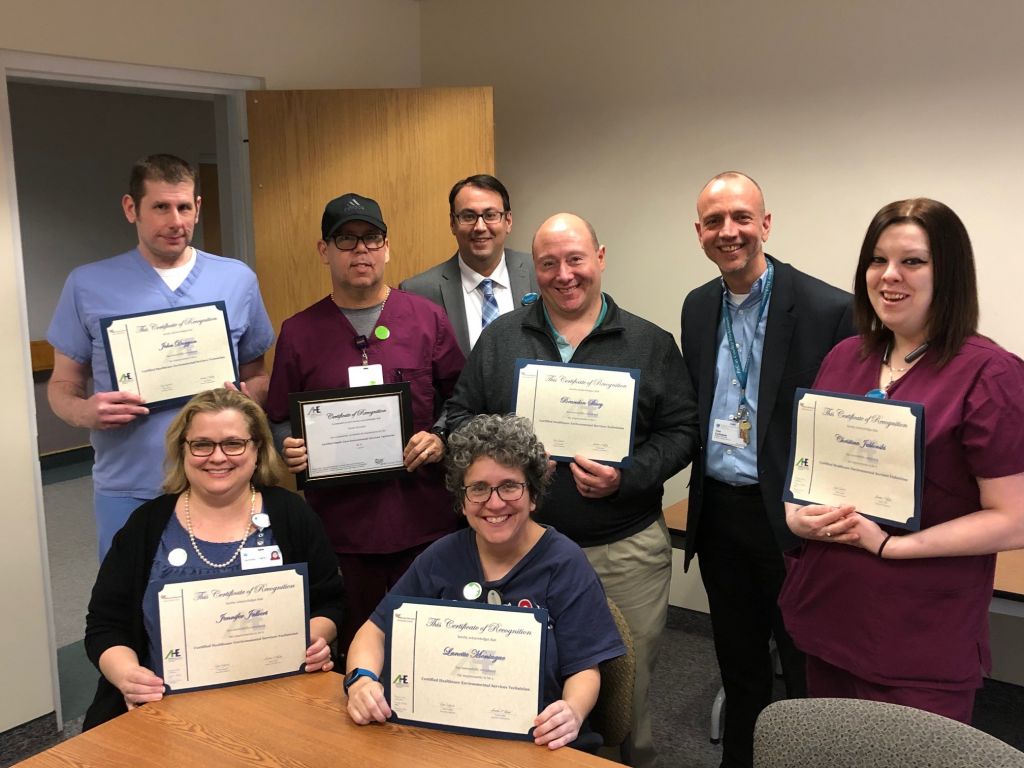January 17, 2020
January 17, 2020

There is a new credential on some Cooley Dickinson Hospital ID badges. It’s CHEST, and no, it has nothing to do with anatomy and physiology.
You’ll find the credential printed on the badges of select members of the Environmental Services team. Six of them are raising the bar for patients as well as their profession, and more staff are expected to follow suit.
“The CHEST – Certified Healthcare Environmental Services Technician – standardizes what we do and clarifies the way we are cleaning,” explains Danny Gonzalez, who has worked in Environmental Services for the past 9 years. “And then we can share what we learn with new and existing employees.”
Last month, Gonzalez, along with colleagues John Duggan, Christina Jablonski, Jennifer Jalbert, Lanette “Lani” Montague, and Brandon Stacy earned certification as Health Care Environmental Services Technicians, or CHEST, a credential that only 101 environmental services workers in Massachusetts – and the only EVS workers to date in western Mass. hospitals – have earned, according to the Association for the Healthcare Environment, the agency that issues the exam. Nationwide, there are approximately 2,900 CHEST-certified workers.
Learning New Skills, Connecting with Patients
“We are beyond proud of the staff,” says Director of Support Services at Cooley Dickinson Tim Culhane, who earned the CHEST-trainer certification in the fall of 2018 and helped proctor members of his team throughout the three-month process of studying and sitting for the exam.
In addition to passing a written exam to earn certification, staff must be well-trained and demonstrate competence in key areas such as the proper disposal of trash and other waste and the myriad of cleaning procedures that are important to stopping the spread of infection in hospitals.
Culhane says there is immense value in the certification process. Not only do the staff learn best practices in cleaning and disinfecting patient rooms and bathrooms, but they also learn skills that help them engage with patients and their visitors. Most importantly, he says, achieving this goal instills a sense of pride in their work and professional accomplishment.
Take 28-year employee John Duggan, who is cross-trained in both Environmental Services and Transportation. Of the certification, Duggan likes that he has learned proper cleaning techniques.
Going through the certification process also validated skills John has relied on for years. “Greeting a patient in a room or prior to transporting them. I am polite; I explain who I am. This certification gives me more flexibility in my role.” Adds Montague, a 32-year employee, “after I am done cleaning, I ask if there is anything I can get or do for the patient.”
Improving the Quality of Care
Proof of employee engagement as well as patient experience improvements, Culhane says, are reflected in Cooley’s HCAHPS scores. (HCAHPS is the Hospital Consumer Assessment of Healthcare Providers and Systems, a patient satisfaction survey required by the Centers for Medicare and Medicaid Services.)
Over the past 12 months, Culhane says, Cooley Dickinson scored over the 50th percentile in the cleanliness domain and “early results for the fourth quarter of 2019 place us in the 75th percentile. This means that Cooley Dickinson is in the top 25 percentile of hospitals across the United States.”
“It’s an astounding achievement,” notes Culhane. “We are demonstrating that we are cleaning to above and beyond best-practice standards and engaging with our patients at the same time.”
Statistics from AHE suggest that of those hospitals that employ CHEST staff, those hospitals show improved patient experience and HCAHPS scores by 10 percentage points and reduced infection rates across the board, including cutting rates of C. diff, a bacterium that causes diarrhea and inflammation of the colon, in half.
In its most recent employee engagement survey, on the question “Our organization emphasizes delivering the best care for its patients,” Cooley Dickinson ranked in the 74th percentile, if you compare the Cooley Dickinson’s EVS team to the 400+ hospitals in the employee engagement database.
“Staff understand they play a vital role in helping to stop the spread of infections and they feel appreciated and part of the clinical team,” he adds.
Looking Forward
CHEST-certification is required for any supervisor-level employee who work in the Support Services division. Culhane notes that goals for his department include recruiting new employees, and working on retaining staff and providing further educational opportunities, including CHEST certification.
Regardless of anyone’s position on the team though, Support Services Manager Jennifer Jalbert says staff are energized and motivated by the first class of CHEST-certified graduates. “CHEST is a nationally recognized program. And it’s rewarding to help raise the bar for Cooley Dickinson. We all want to be part of that!”
Adds Danny, “at the end of the day, you feel satisfaction. When I see a patient discharged from Cooley Dickinson, I think, ‘we did everything we could to help that patient.’”
Previous
The New Faces: 2019

